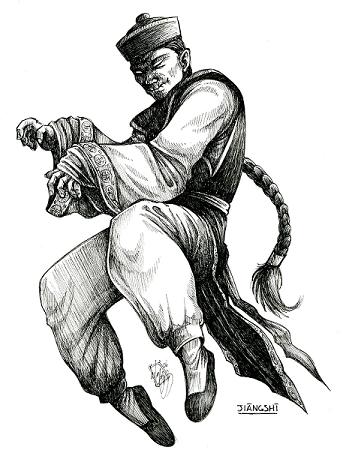April 6, 2010
Hippity, hoppity…
Who knew the vampire myth scaled the globe in so many places? Apparently the Chinese also have a popular vampire myth called the Xiang Shi or the Chiang Shih. The belief in the Xiang Shi is derived from the Chinese concept of each person having two souls. One soul was seen as the superior, rational soul while the second was called the inferior, irrational soul. The former soul had the form of the body and upon separating, the soul could appear as the body’s exact double. This superior soul could wander the countryside and could even possess another body, sometimes taking the form of an animal. Negative repercussions could occur if accidents happened while this superior soul wandered about outside of its physical body.
The inferior soul, sometimes called the p’ai or p’o, sometimes lingered in the body following death, leading to unnatural preservation. When this inferior soul left the body, the remains disintegrated. Occasionally, if the inferior soul was strong it could inhabit the body for long periods of time and even use the remains for its own ends.
When the inferior soul took charge of the corpse it became the Xiang Shi. The Xiang Shi could take on a green phosphorescent glow and it also had serrated teeth and long talons. The Xiang Shi, along with many other vampire-like mythical creatures, may have originated to explain problems associated with death. The Xiang Shi arose following violent death by suicide, hanging, drowning, smothering and also if the person died suddenly or as a result of improper burial procedures. The dead were thought to become angry if the burial process was postponed too long and since the Xiang Shi could not dematerialize, they could not rise from the grave. Thus, transformation took place before burial. So, it is possible that the Xiang Shi myth acted as an impetus to hasten the burial process.
The Xiang Shi had several supernatural attributes. Cats were kept away from corpses, since it was believed that if the cat jumped over the corpse it would turn into a Xiang Shi. Xiang Shi, like the vampire Count Dracula, can transform into wolves. The Xiang Shi also had trouble crossing running water, and it had to surprise victims since it had few other powers to lure or entrance its prey. The Chinese Vampire was extremely vicious, since it would often rip off the heads or limbs of its victims, and it also had a strong sexual drive, leading it to rape or attack women. Over time the vampire would gain strength and would eventually develop a covering of long white hair, and it would be able to fly after this transformation. It was possible for an unburied body segment, like a head, to become reanimated and transform into a Xiang Shi. Salt was said to have a corrosive effect on the Xiang Shi’s skin, which lent its use as a protection against the vampire. Garlic was also used to protect against the vampire. Loud noises like thunder could disable or kill the Xiang Shi, and weapons like brooms could be used to sweep the Xiang Shi back into its resting spot, leaving it helpless. Iron fillings, rice and red peas were all used as barriers to the entry of the Xiang Shi, and were often placed around a vacant coffin to prevent the vampire from taking a new resting place. If this myth is very interesting to you, try reading the short story “The Resuscitated Corpse” written by P’u Sung-Ling.
Above: An image depicting a “hopping” vampire from Chinese popular culture.
Chinese film gave new life to the myth of the Xiang Shi. Many of the Chinese vampire films focusing on this myth are comedies, based on the early failings of vampire horror films. Instead of trying to make the films actually scary, the film makers embraced the comedy and changed the myth into a comedic genre. These films featured what came to be known as hopping vampires, since the vampires depicted in the films wore loose robes and hopped about to move around. These hopping vampires were said to be subdued by magical talismans. Holding one’s breath could also temporarily stop the hopping vampire, and eating sticky rice was said to be an antidote against their bite. These comedic movies in essence created a separate vampire myth, loosely based on the earlier myth and legends told in China, which has surpassed the former myths in popularity.
Above I have embedded a clip from a Chinese film called “Dragon Reloaded.” The film is a comedy and this scene is a spoof off of a popular Chinese vampire series, called Mr. Vampire. To learn more about the film check out this site!
Filed by ltello at April 6th, 2010 under Legends/Folklore
84 persons have commented this post


really good luck together with your blogging site! you won me as a follower
Loving the information on this website , you have done great job on the posts .